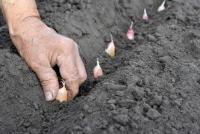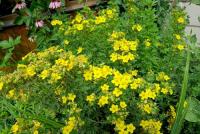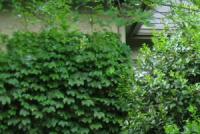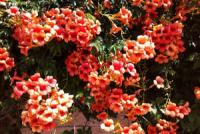Campsis tree liana. Campsis - growing and care
Five years ago I rested on the Black Sea coast, and for the first time I saw a gorgeous liana. She struck me with her beauty, brightness and power. Before my departure, I dug up the root offspring that I brought home.
Soon I found information about this plant, which, as it turned out, had two names — Kampsis and Tekma. I began to understand the features of its growth and development. I found out that it is a woody deciduous liana, which belongs to the bignonium family. There are two types of Campsys, which I decided to grow, and Campsis delights with its flowers, which are collected in a brush and reach 10 cm in length, and the odd-pomerically pedigree leaves of the plant are beautiful.
Where to plant kampsis
I put the liana in a large container and allowed her to sleep in her house in an unheated veranda. In the second half of May, the plant landed on a permanent place near the south side of the fence in loose fertile soil. In some publications I met information that limestone was suitable for the campsis. After transplanting, she poured abundantly and made a support to send the vine to the fence.
Once in the spring and once in the summer I make nitrogen-phosphorus fertilizer. I propagate the vine by cuttings or undergrowth, I am so used to it, but you can also sow seeds.
How to care for Kampsis
Campsis is a very thermophilic liana, and in my edges there are severe frosts. Therefore, the shelter of the plant for the winter is very important. When the cold comes, I try to remove the liana and cover it with spruce leaves, and above it with dry foliage. Do this procedure should be in dry weather.
In the winter I try to sketch more snow for cover. I spend spring pruning, leaving 3-4 escapes. Once during the dry period, my liana was attacked by aphid.
Struggling with a harmful insect, sprinkling with a solution of household soap. As though I was not in love with this vine, I still have to admit that it has negative sides. First, the insects are very fond of the plant - and flying, and crawling, therefore I do not recommend growing a vine near the windows. Secondly, Kampsis fully justifies its name - rooting. If you grow it near a building, the roots cling and grow into a tree, and even a brick. If you decide to create a green wall with beautiful flowers - this should be for a long time, since it is very difficult to destroy the growth of creepers. Besides, Kampsis plentifully launches root shoots, so you should make sure that it does not conquer an area larger than its allotment. Thirdly, the creepers are very beautiful, but they bloom only a day or two, then they fall off, instead of them new ones appear, so almost every day you have to sweep the ground under the vine.It’s already four years since I landed the campsis in the ground, and only this year he pleased me with a truly abundant flowering. Recently I learned that with constant pruning the vines it can be grown as a home plant, I want to experiment. About I will write successes or failures. I hope that my recommendations regarding the Kampsis of rooting will be useful to readers. Let your favorite and healthy plants be in your gardens.
Kaprifol - fragrant liana. Leaving in the spring.
Campsis Planting and care
Surely, while on vacation, you have seen a hedge completely covered with a flowering vine, the flowers of which resemble gramophone. Many amateur growers would like to grow a plant at home, but they lost to Kampsis — that is the name of this vine — every interest in finding out about its heat-loving disposition.
The plant, which is familiar to the southern regions, can easily be grown in the middle lane if desired. Campsis is an unpretentious plant. Plant it in a sunny, draft-free place and plenty of flowering is guaranteed.
Campsis is not afraid of drought, but this does not mean that it does not need to be watered. Water it regularly and plentifully. To preserve moisture, the soil at the roots of the plant is mulched with peat or sawdust.
To feedings Kampsis special requirements does not impose. For maximum long and bright flowering, feed the plant twice a month with complex fertilizer with nitrogen and phosphorus. Wintering KampsisPerhaps the most crucial moment.
In areas where winters are traditionally mild, there is nothing to worry about. But if the temperature is often long and below -20 degrees, then there is no way without shelter. This procedure is quite simple. Entirely the whole plant is covered - both stems and roots.
The stems must be removed from the support, laid on the ground and covered with spruce branches, sawdust or leaves. After that, the "hill" to cover with plastic wrap. Every year Kampsis required trimming and shaping.
A properly formed plant will be more attractive. Regular pruning stimulates abundant flowering, as flowers form only on young shoots. From the first years of your life, form a Kampsisu framework of three to four branches.
And the young shoots that have grown over the year are ruthlessly removed. Multiply kampsis can be cuttings, layering or seed. Seed method is quite simple, but not popular, in which case you will have to wait for 7-8 years to bloom. It is quite simple to propagate the campsis by layering.
Escape, growing as close as possible to the ground, pin and stick, and cover the ground above the cuttings with plastic wrap in order to increase the soil moisture. From the ingrained otvodka next spring will get a new plant. You can get a young plant with the help of root shoots.
To do this, in springtime, before the onset of the vegetation phase, separate the process from the root from the main plant and plant it in a permanent place. For propagation of the Campsis, the cutting method is also used. In early spring, last year's well-woody (only not green) cuttings are cut and planted in a permanent, non-sunny place.
If the winters in your region are particularly frosty, cuttings should then be planted in containers that you can easily put in a cool and bright room for the winter. If the winters are very cold and the shelter does not help, the campsis can be “domesticated”. With proper care and regular pruning, a garden plant can become a room vine.
Garden Encyclopedia. Campsis: growing and care.
Characteristics of Campsis
Campsis (Campsis) is a genus of thermophilic perennial deciduous lianas from the Bignoniaceae family (Bignoniaceae), numbering only 2 species: - Campsys grandiflora (Campsis grandiflora, or Bignonia grandiflora), aka Campsis chisens (Campsis chinensis), grows wildly, it is a growing child, and it is a growing child. Asia (more precisely: in China and Japan). "Able", twisting the support with the ends of his shoots, to come closer along it to the sky at 6-8 meters. Sometimes takes the form of a low bush.
Delightful and in a form. Bright orange flowers (up to 8 centimeters in diameter, looking like a smooth combination of a wide funnel with an elongated tube) show for the first time 2nd or 3rd summer after planting seedlings in open ground.
It tolerates frosts down to minus 18 ° C, but only briefly. The length of the leaves does not exceed 6 centimeters. Introduced into culture since 1800; - Campsis rooting (Campsis radicans, or Bignonia radicans), also known as Tecomaria radicans, originates from North America.
Sticking to the support (even to the window glass) by dozens of air roots, produced by the stems, rises to a height of up to 15 meters (the leaves perfectly correspond to this “Guards” growth - their length reaches 20 centimeters). A skilled gardener can be formed as an erect tree.
Equally “fiery” flowers (up to 5 centimeters in diameter, up to 9 centimeters long) with a scarlet limb combine 10-15 pieces into apical brushes, not all of them are revealed at once, but successively (therefore, flowering has a long duration and abundance). Maintains short-term lowering of temperature to minus 20 ° C.
It has been cultivated in Europe since 1640. And since 1883, the hybrid of these two species - Campsis Tagliba (Campsis - hybrida = Campsis - tagliabuana = Tecoma tagliabuana) - undertook to gain wide popularity. It is often a shrub, and with spreading branches.
The size of the flowers is similar to Campsis grandiflora, the degree of cold resistance - from Campsis radicans. The foreign Internet site GRIN (for more information about it, see “Schefflera”) mentions the third species Campsis fortunei (= Paulownia fortunei), however, it immediately refers to the Paulowniaceae family (not Bignoniaceae). Tecoma or Tecomaria are synonyms of another kind (covering about 40 different species) from the Bignonia family — often used as names of Campsis, which, strictly speaking, is a mistake. The colloquial version of "Tykom" generally sounds rude.
Do not repeat these blunders, please. Much better nicknames "Trumpeter" and "Trubkotsvet", being among fans. “Virginian jasmine” is beautiful ... and, alas, not very correct, because Campsis does not emit an aroma that is accessible to the human sense of smell. (For the bee and ant smells, their smell is quite accessible and very attractive.) In their genus there are varieties with a different color of flowers: scarlet (purple), purple, yellow, classically orange, red-orange or bright red.
The decorative effect is enhanced by dark green odd-pinnate opposite leaves consisting of 7-11 leaflets with serrated edges, effectively looking against the background of walls and other elements of garden structures. Do not bother about the construction of a trivial support extended along a vertical like a flagpole. Try instead to make a figure-like structure in the middle of a lawn, which Campsys rooting will transform into a ball, a prism cut into a ball or a cylinder, a truncated cone or a pyramid with a top hidden in the ground.
Try to use this plant as a groundcover. Secrets of successful cultivation of Campsys It is light-requiring (and along with insolation, the sum of summer temperatures is also important for good flowering). Prefers light, loose soil (“agrees” to loam). It will develop confidently and quickly if it is endowed with wealth (fertility) and moderate humidity.
Consequently, additional feeding and regular watering are necessary (especially during flowering: at Campsys Chinese it takes place in August-September, at Campsis's rooting - from June to October frosts). The list of breeding methods starts with the line "seeds". In the seedling box they lay in March.
After 20-25 days, shoots appear, which in May can be moved to normal ground. If sowing is done in the fall, then a preliminary stratification of the seeds will be required (see in the article “Kandyk”), and they will germinate in 60-100 days. Alternative multiplication materials: - root growth; - cuttings; - cuttings from one-year shoots rooted in the sand.
From the rooted cutting at the start of the first growing season, all shoots are broken, except 2-4 strongest ones. They must make up the “skeleton” of the specimen, that is, to the finish of the growing season, reach 250-300 centimeters in length and solidly woody.
Perhaps for this young Campsis will have to spend a whole summer in a container. In the winter the container will be demolished in a cold basement. If for a year the necessary conditions "skeletal" stems did not get - continues to grow in the container.
If you have acquired - in the spring, landing is made in the intended place under the sun. In the southern regions (on the Black Sea coast of the Caucasus, for example), grafting is acceptable. Planning to get a standard form, “Chinese” are planted about 10 centimeters above the ground on the stem of a tree of the genus Catalpa (Catalpa), also belonging to the Bignoniev family. Campsis cutting (it transfers it without suffering) is a multi-purpose and multiphase procedure.
First, it determines the decent appearance of the plant (remove small shoots, save the “skeletal” ones). Secondly, annually in the spring, shorten the last year's shoots by 2-3 buds, since the inflorescences are formed at the ends of only those shoots that are released by the matured stems in the current year.
Thirdly, for the sake of rejuvenation, cut off once every 5-6 years all shoots almost to the ground (do not expose the lowest tier). In the complex of cosmetic measures they also include tying. In the fall, remove the vine from the support, put it on the foliage (not on the fallen leaves : it rots) and sprinkle with earth. It is possible to organize wintering for the “guardsman” in a different way: transfer to a cool greenhouse, continue to water moderately, cut the flowered branches in February. Campsys is not subject to any diseases or attacks of insect pests. Hiding it before winter, invent and provide reliable protection from small rodents. If you don’t comb out faded flowers from your brushes (and they wither no more than 50 hours after they bloom), then in a couple of weeks Campsys rooting will acquire a sort of garbage heap. If the "Guards" lash falls on a wet one the substrate, then after a few days to tear it away without damage, do not dream. (But you need to tear off if you do not want to spread to the entire lawn.) If you dig Campsis without thoroughness, then new shoots will soon “shoot” from the ground in its place (thanks to the super-duper-vitality of the root system). Glyphosate (a herbicide that has become famous "Roundup" and "Hurricane") in such situations does not help out. Plants tend to declare aggressive the lazy owners, who have the ability to "eat through" the foundation, break the floor, squeeze the windows, flood the attic, and drop the roof, and from the nostrils to gag ... But really does not recommend Campus planted in close proximity to wells, basins, artesian wells, because, having entrenched water, in its striving for it, it will penetrate the roots even through reinforced concrete.
Growing Kampsis (Tacoma)
Campsis - Deciduous liana family Bignonievyh, home - China and North America. This fast-growing liana forms airy suckers, clinging to the support, and can climb to a height of 15 m. Campsis is very decorative, resistant to urban conditions, smoke and gas resistant.
However, the thermophilicity of this plant prevents its widespread use in regions with cold winters. Campsis grows well and blooms profusely in a mild climate, in more severe conditions, this heat-loving vine requires shelter for the winter.
Large flowers of a tubular-funnel shape, 8–9 cm long and 5 cm in diameter, give the main decorative effect to this liana. Depending on the variety, flowers of capsis are orange, pink, red-golden, and crimson.
The first flowers begin to bloom in mid-June, flowering continues until September. Types and varieties of Kampsis: - Campsis rooting (Campsis radicans) hails from North America. It reaches 7-9 m in height.
Campsis rooting is a large creeper with numerous aerial roots on the stems with which it rises on a support. The leaves consist of 9-11 leaflets with characteristic pubescence from the bottom (solid or only along the veins).
Large, tubular flowers reach 6 cm in length and form apical racemes of 10-15 flowers. Flowers with bright orange halo and bright red limb. Heat-loving, but withstands short-term lowering of temperature to -20 ° C. Varieties of this species:
- Flamenco with bright red flowers. His shoots grow in length up to 5 m, and flowering continues from July to October (in the absence of frosts). Flava it also grows to 5 m, but its flowers are light yellow and the flowering period is slightly shorter - from July to September.
- Campsis big-floweredor Chinese (Campsis grandiflora) grows in nature in China and Japan. In contrast, rooting kampsis has no aerial roots and twines around the support with the ends of shoots.
Single-pinnate leaves carry 7–9 leaflets up to 6 cm long, from the bottom without pubescence. But the tubular funnel-shaped flowers of this species are much larger, up to 8 cm, than on the campsis of rooting, bright, fiery orange color.
Reaches a smaller height, sometimes grows even in the form of a low bush. At the time of flowering comes in 2-3 year. Less frost-resistant, tolerates short-term frosts up to -18 ° С without damage.
More colorful than Kampsis rooted due to larger flowers and abundant flowering. - Campsis Tagliabuan (Campsis tagliabuana) is a hybrid species resembling Campesis grandiflora. Campsis Tagliabuansky reaches 4-6 m in height.
Growing, it forms a bush. This hybrid rises worse on supports. For decorative qualities, it is closer to the grandiflora Kampsis, and winter-hardy to the rooting one. Variety of this species:
- Madame galen forms orange-red flowers.
Location Campsys is light-requiring, requires a secure location. It is unpretentious to the soil and can grow even on heavy loams, but grows better and blooms profusely on fertile soil.
Demanding to stable moisture and fertility of the substrate. With sufficient nitrogen-phosphorus nutrition increases and increases the duration of flowering. Old faded stems are best pruned at the end of winter.
Like most lianas, kampsis is prone to pruning, so if desired, the plant can be given any shape.
Cultivation and care
It should be remembered that the flowers in Kampsis appear on the shoots of the current year, growing from perennial stems, which must be properly formed. Usually the plant is formed in two to four main shoots.
They will be the core and bear the main load during flowering. At the base of the aerial part too many shoots are formed, they must be cut out as they will interfere with the development of the main part.
Small side shoots should be removed from the bush, taking care only of the “skeletal” branches. If the climate in your area is quite harsh in winter (the air temperature is below -20 ° C), take care of the winter campsis. To do this, the support for the plant must be made removable, for example, from synthetic cord.
Before the onset of frost, the whips are removed along with the support and laid on the ground. They are covered with spruce leaves, dry plant residues. Reproduction. Easily propagated by seeds, root shoots, cuttings and layering. Seed propagated rarely.
- Reproduction of kampsis by seeds rarely used - mainly in cases where vegetative reproduction is difficult. A plant grown from seed will bloom only in the seventh or eighth year. - Root planting - the fastest and most effective way of reproduction of the kampsis.
Root growths are processes that are abundantly formed around mature plants. This process is cut off with a piece of root, when the plant has not yet entered the phase of active growth, and landed in a permanent place.
- Reproduction by green cuttings produced in June and July. Cuttings are cut from the central part of the shoots, on which 2-3 leaves are left and planted obliquely in loose, fertile soil in partial shade.
It is advisable to soil the soil with a thin layer of leaves to reduce evaporation of moisture. The survival rate of the green cuttings of the Campsis is quite high, reaching 90%.
- Lignified cuttings of Kampsis cut in early spring from the shoots of last year's growth, planted obliquely. It can be planted immediately to a permanent place, since the survival rate of winter cuttings of the Kampsis is almost 100%.
- Reproduction of the campsis by layering should be used for shoots located low above the ground. Lignified or green shoots of Kampsis just enough to pin to the ground.
But it is necessary to ensure that the soil during the rooting of the shoots is constantly wet, then the shoots of the Kapsis take root during the season. In the spring of next year, they are separated from the parent plant and planted in a permanent place.
The propagated kampsis develops very quickly. Using. For vertical gardening fences and facades of houses, as well as grown in nizkoshtambovoy form in the form of a small tree.
|
In childhood, we christened the plant with an orange gramophone. This flower - creeper liana (kampsis). Planting, care, cultivation, reproduction deserve attention, as it has an extraordinary decorative effect (photo), it is able to close unsightly fences and walls, it is unpretentious, frost-resistant. How many names this flower has - kampsis, tekka, trumpet flower, but one thing is for sure - this is a perennial plant that tolerates frost well (sometimes it still needs shelter), deciduous. The stalk winds around the support spiral. Therefore, sometimes the stems, intertwined, form bizarre forms. And the very creeper near the earth resembles the trunk of a bizarre tree. Above it is crowned with a lush cap of dark green feathery leaves up to 40 cm long and tubular bright orange flowers gathered in drooping brushes. Well, what is not the crown of the tree. The flowers all summer. As you can see, there are flowers in the brush and flowers, and opened, and a lot of buds. So gramafonchiki will please us for a long time, decorating a flower garden with bright spots. But even then the view will be elegant, as long boxes will be tied in place of flowers, capable of hanging for a long time, even sometimes all winter. The most common can be called Kampsis rooting. The creeper is up to 3 meters long, the shoots are brownish, up to 5 cm thick. Although often the creeper creeper can reach 10-15 meters, taking hold of the trellis, climbing to the roof, covering the low house with a hat. When planting, the tekom is not demanding on the soil, but still, for greater decorativeness, select either fertile places, or carefully prepare the landing pit. After all, will have to grow in one place for many years. Pick up sunny places, there is growth and flowering will be better. Landing Kampsis is held in the spring prepared in the autumn pits. Size 40 * 50 * 50. Add 500 grams of complete mineral fertilizer, 5 kg of humus. Hurry up, the best survival rate can be ensured in time before the bud break. For breeding, you can use seeds. There are a lot of them in boxes. But before planting, it is necessary to stratify. This is for spring sowing. If the seeds dry up, their germination decreases. Therefore, it is better to use vegetative methods - cuttings, root and green cuttings, root scions. As already mentioned, one of the most common types is Campsis. Reproduction is simple, comes from the name itself. Take a closer look, on the shoots you will see small sleeping air roots. Take and simply pin to the ground any escape (you can put in a small hole). The soil in this place must be kept wet. By the spring of next year, it will be possible to separate the new plant. But this ability to take root may not please everyone. Since the roots are able to penetrate the masonry walls and wooden window frames. Therefore, it is better to use specially designed supports, and not just throw a vine on the wall. Flower campsis care almost does not require. You can not even fertilize. The plant is able to penetrate deep into the ground. Of course, especially after planting you need to water. If there is a drought, then pour 3 times per season, giving 30 liters under a bush. Loosen the earth, get rid of weeds. And if you feed it, for example, with an extract of ashes or plants, the flowering will be even more magnificent. Often form 2-4 main escape. A trifle growing close to the ground is pruned. Thus, it turns out several skeletal shoots. Often faded shoots pruned into 3 peepholes. But nevertheless the tekoma well grows both after cutting, and after freezing. So boldly with a pruner give it different forms, create green hedges or keep within the size of a bush. Using special designs, you can get in your flower garden a cube, a ball, or some fancy shape woven over with a vine. He deals with diseases and pests perfectly, until they noticed. But in the spring do not worry. At first, it may seem to you that the vine has dried up, it just does not manifest itself early. Little green hedgehogs will start to appear, in bunches. Little by little, little by little, and then once and growth will go a stormy wave. Photos of flowers kampsis (increase by click) |
Perennial Kampsis, which is also referred to as a texta or bignonia, occurs quite often in gardening. This flowering deciduous woody plant is valued for its unusual decorativeness. It is very profitable to grow such vines for braiding arbors, fences and other supports. However, it is worthwhile to know in advance where the landing of the Kampsis will give the best results at the site. And also, what care is necessary for a plant.
Plant description
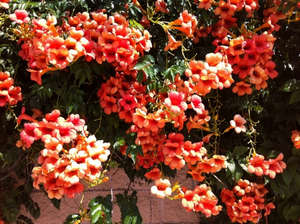 Campsis is a native of the tropics, which tells us about the thermophilicity of the plant. It also has a fairly good frost resistance, however, its cultivation in regions with a constantly cold climate is complicated due to the natural properties of the crop.
Campsis is a native of the tropics, which tells us about the thermophilicity of the plant. It also has a fairly good frost resistance, however, its cultivation in regions with a constantly cold climate is complicated due to the natural properties of the crop.
At the moment, the tech liana is very popular in gardening. This is due to the uncomplicated and original forms of the plant, which are formed by the climbing stem.
The spring campsis does not wake up early. Therefore, the threat of leaving frosts is not terrible shoots. Young shoots of green plants. But as far as "growing up", the shoots woody, become a sturdy stem of light brown color. Such a vine comes to life after the cold season near the end of May, and in early June it will please the owner with lush green foliage.
Kampsis blooms with tubular flowers resembling gramophone. They can be yellow, red and orange.
How to plant such a plant on the site
 Planting kampsis on the site can be carried out with the help of seeds. They are sold in almost every flower shop in small packages with photos. Those gardeners who have been growing a similar crop in their garden for more than one year, collect the seeds themselves, the fruit-boxes of ripe flowers ( see photo).
Planting kampsis on the site can be carried out with the help of seeds. They are sold in almost every flower shop in small packages with photos. Those gardeners who have been growing a similar crop in their garden for more than one year, collect the seeds themselves, the fruit-boxes of ripe flowers ( see photo).
Seeds before planting require special care. It is necessary to carry out preseeding preparation in the form of stratification It will provide accelerated germination of seedlings and good germination. But such procedures are carried out if the seed planting culture is carried out in the spring. With this method of cultivation, it should be remembered that the plant will bloom only after 7-8 years. Therefore, lovers of decorative flowers rarely choose this method.
Often, of course, when it is possible, gardeners prefer to start growing with planting kampsis in the following ways.
Root planting
Such a landing is considered the easiest, fastest and most effective. The shoot to be planted is cut off from an adult plant with a piece of root. Such shoots, as a rule, grow abundantly in the soil near adult vines.
Pruning is done until the active growth stage of capmesis occurs. Cut off shoots are transplanted to a permanent place immediately.
Rooting of green cuttings
 Cuttings, which are planted in June and July, are cut from the central part of the shoots. Each such cutting should have 2-3 leaves. Landing cuttings in the ground provides for their inclined placement in the hole with further mulching. If you carry out the correct planting of green cuttings and provide them with proper care, then the probability of a good increase will be 90%.
Cuttings, which are planted in June and July, are cut from the central part of the shoots. Each such cutting should have 2-3 leaves. Landing cuttings in the ground provides for their inclined placement in the hole with further mulching. If you carry out the correct planting of green cuttings and provide them with proper care, then the probability of a good increase will be 90%.
Planting lignified cuttings
Using non-young cuttings for planting, they can also be immediately rooted in a permanent place. If you want the cuttings to take root well, you should cut off the planting material in the form of shoots from the growth of last year. It is necessary to carry out such procedures (cutting and planting) in early spring. More about this method in the video.
Rooting otvodok
For such a method, layering located on the ground itself is used. To carry out such a process is not at all difficult; it is enough just to “pin” the layering to the ground. However, in this case, constant care will be required in terms of soil moisture. Rooting of layers will take about a season. And next year, in the spring, they can be separated and planted in a permanent place.
Planting plants, therefore, gives very good results, as the campsis very quickly begins to develop and grow.
Where to plant vines
 When choosing a site for planting kampsis, you should know that the smell of the plant attracts many insects. Including wasps and hornets. Therefore, do not rush to plant a plant under the windows of houses. Also not recommended planting of such plants against the walls of bricks. Since, growing, the plant may well penetrate between the bricks and damage the clade, which is fraught with not very pleasant consequences.
When choosing a site for planting kampsis, you should know that the smell of the plant attracts many insects. Including wasps and hornets. Therefore, do not rush to plant a plant under the windows of houses. Also not recommended planting of such plants against the walls of bricks. Since, growing, the plant may well penetrate between the bricks and damage the clade, which is fraught with not very pleasant consequences.
It is better to allocate a place to the fences and fences of vines, so that by braiding them, they would form a hedge. As previously mentioned, gardeners use tekan vine to decorate garden arches and arbors.
How to care for a plant
 Campsis is completely unpretentious. And it can grow on any soil, even if the care will be minimal. But still the best conditions for growing vines are fertile soils and regular watering, as well as constant pruning.
Campsis is completely unpretentious. And it can grow on any soil, even if the care will be minimal. But still the best conditions for growing vines are fertile soils and regular watering, as well as constant pruning.
So, if in a place where planting of the Kampsis is planned, the soil is rather poor, then it is better to apply fertilizer (and in the spring planting since autumn). Compost and complex fertilizers are suitable. During the flowering period is also recommended to feed the vines. For these purposes, use potash-phosphate fertilizer, making it at least twice over the entire period of active growing season.
Pruning plants should be carried out as it matures, cutting off only those shoots that died in the winter. You can also cut the vine for its greater decorativeness, giving the bush non-standard forms.
Campsys, the planting and maintenance of which, as you can see, is very simple, shows that it is ideal for beginner gardeners. Moreover, the result is worth it to start growing a crop on the site.
Campsis is a beautiful fast growing liana of the Bignoniev family. Homeland plants are North America and China. In Europe, it has been actively used to decorate gardens since the 17th century. By the walls or the fence, the campsis forms dense thickets with spreading shoots, which are covered with large and bright colors. Liana perfectly survives in the open ground of the southern regions and central Russia. In the people it is also known under the name "tekk". Having mastered the simple rules of care, any gardener can easily achieve flowering and tame the growth of lush beauty.
Botanical description
Campsis is a fast-growing, deciduous perennial with a developed rhizome. The roots spread not only inland, but also occupy a vast territory. Young shoots may appear at a distance of several meters from the main thickets.
Young shoots have a smooth green bark. As they age, they lignify and become red-brown in color. In the internodes there are aerial roots and a pair of opposite leaves on long petioles. Each petiole carries 7-11 oval or ovate leaf plates. Jagged edges on the leaves. The front surface is glossy, and the reverse has a slight pubescence along the main veins.


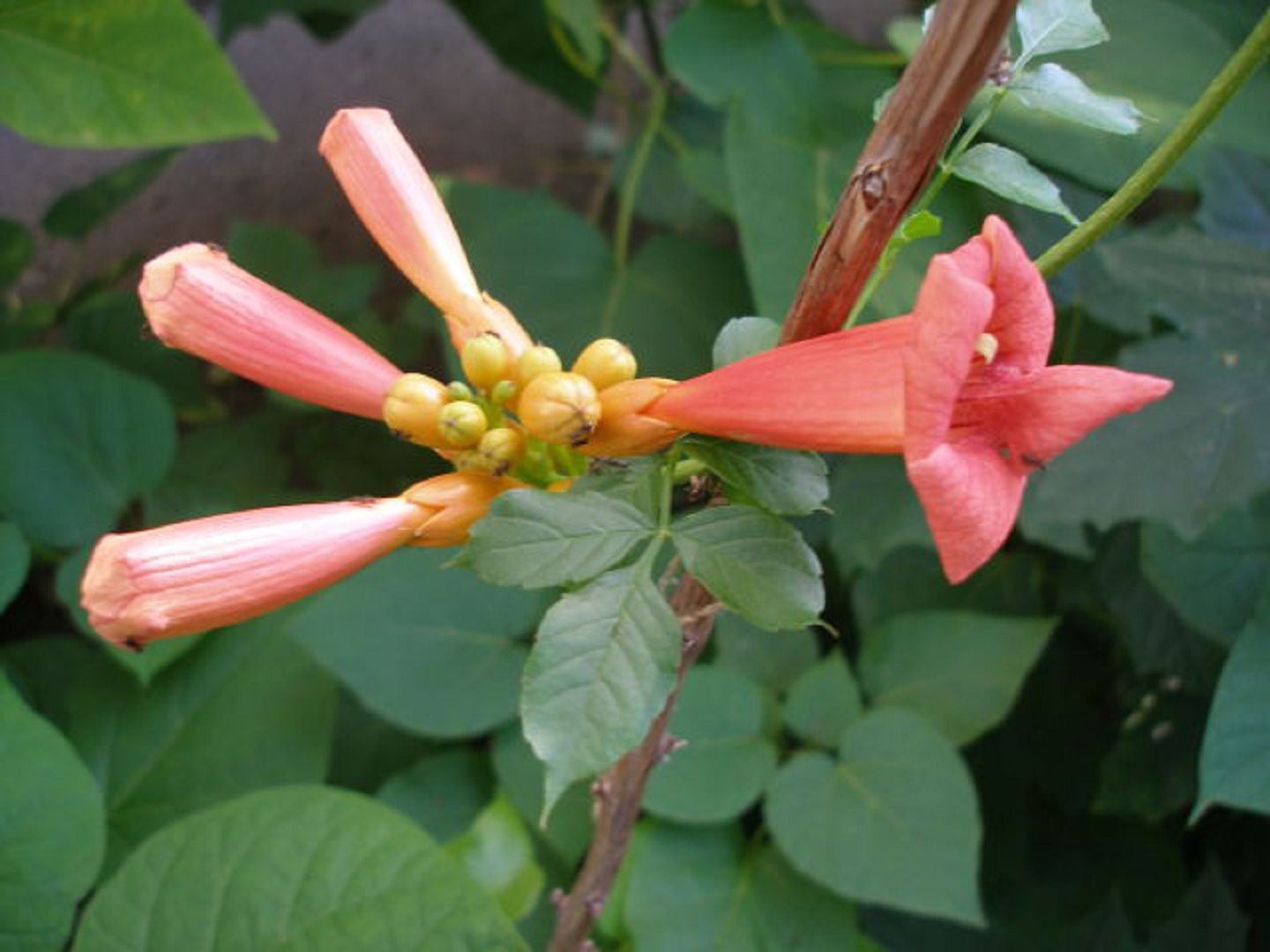
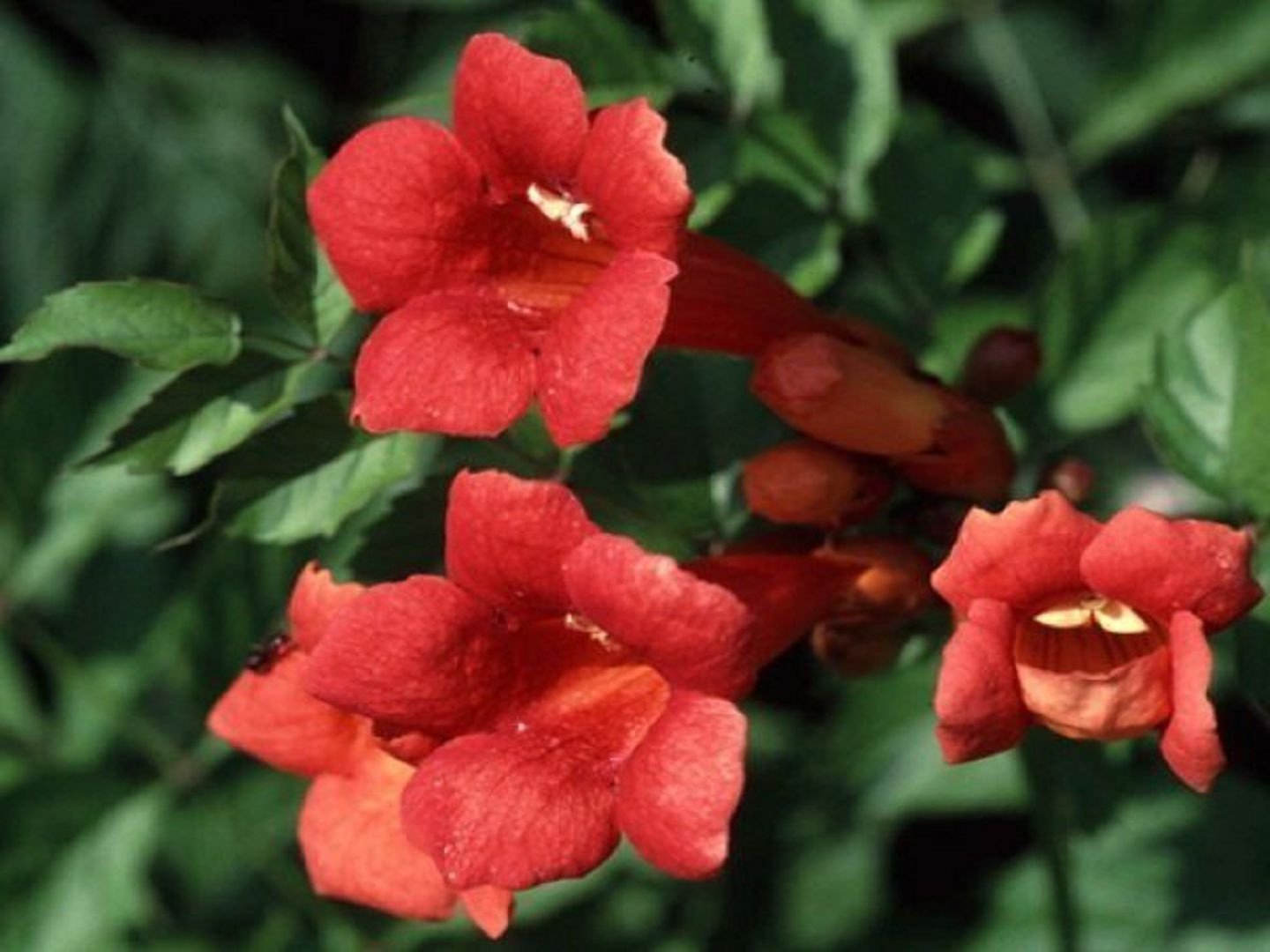

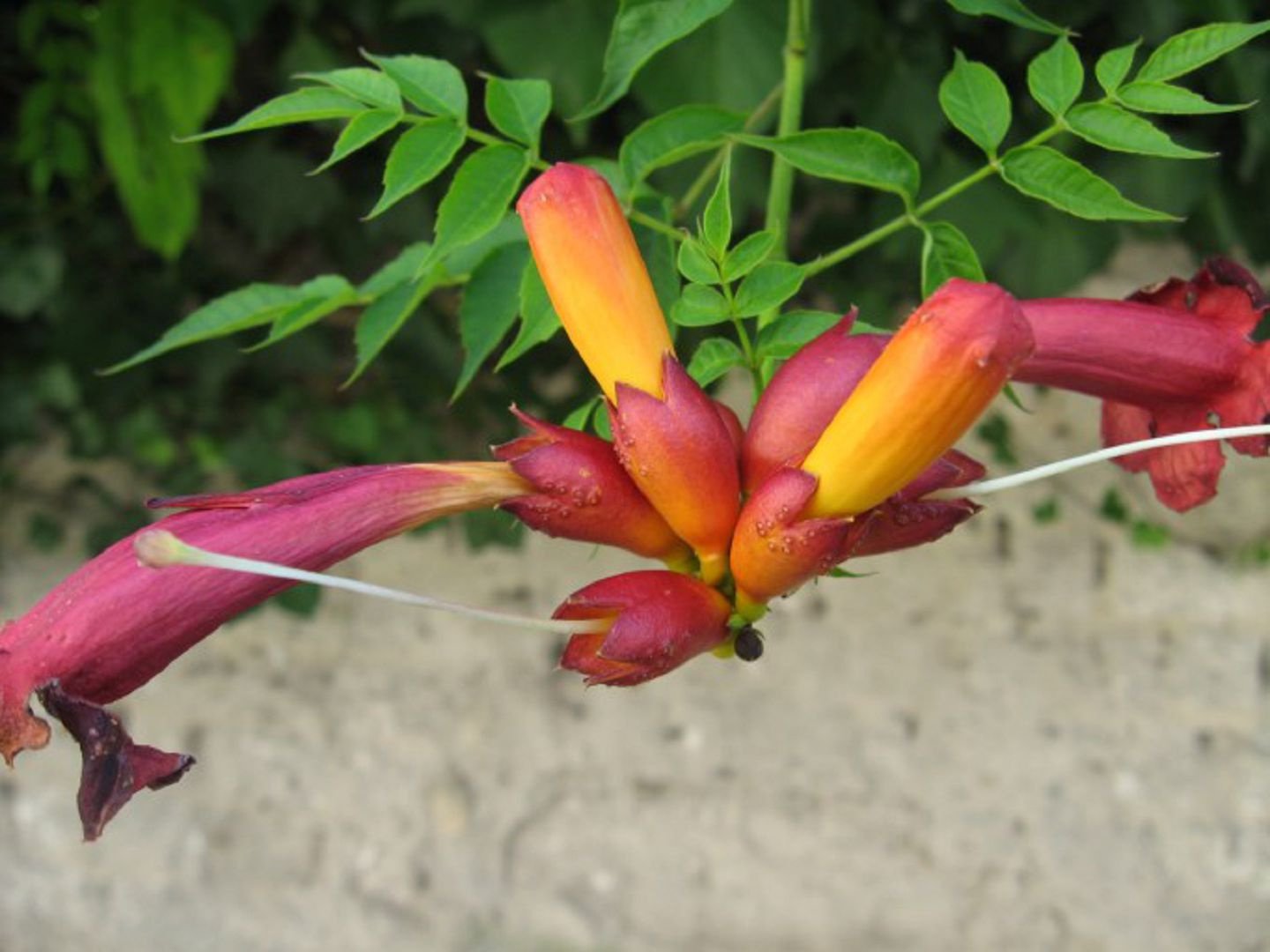

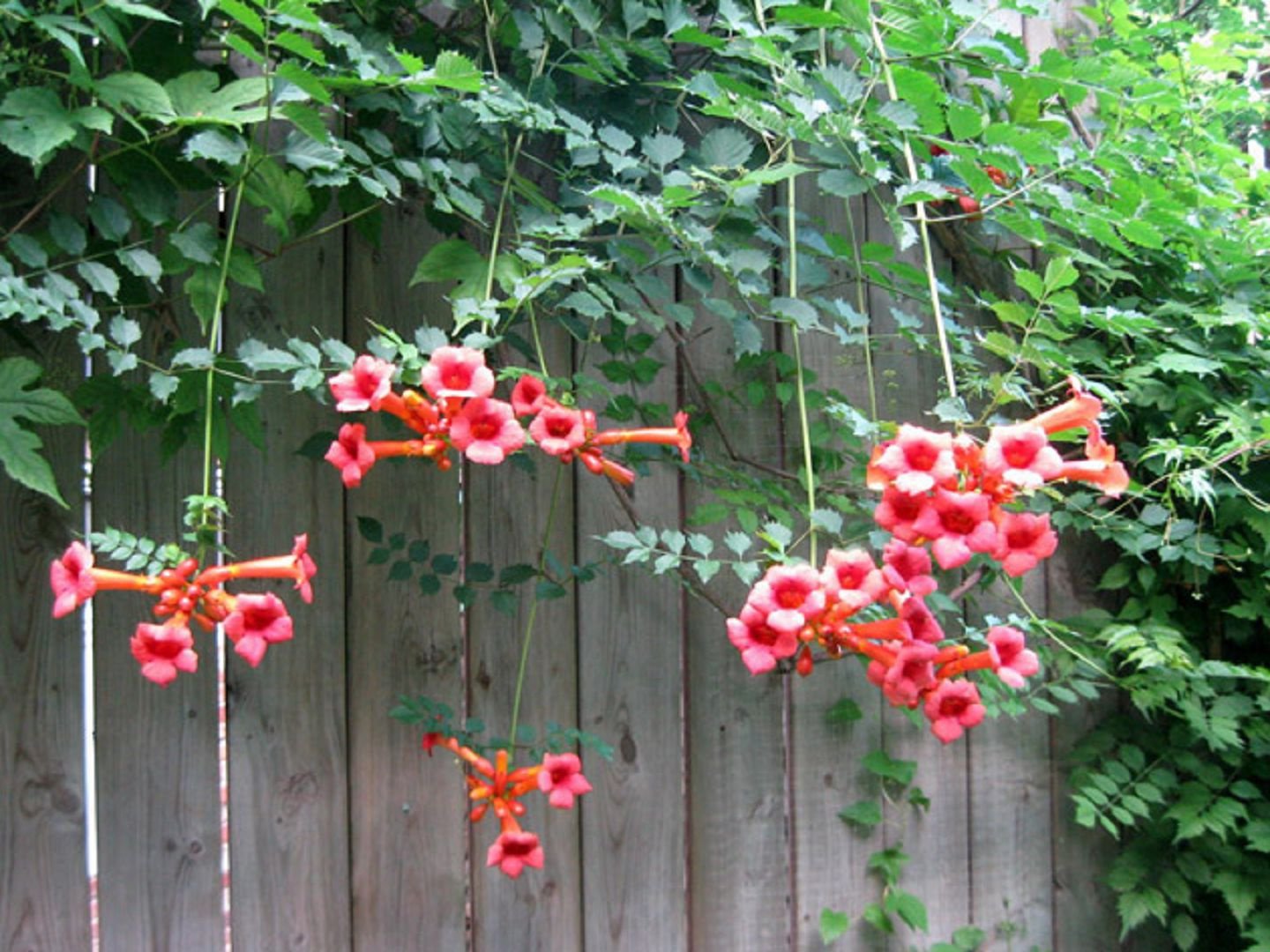
![]()
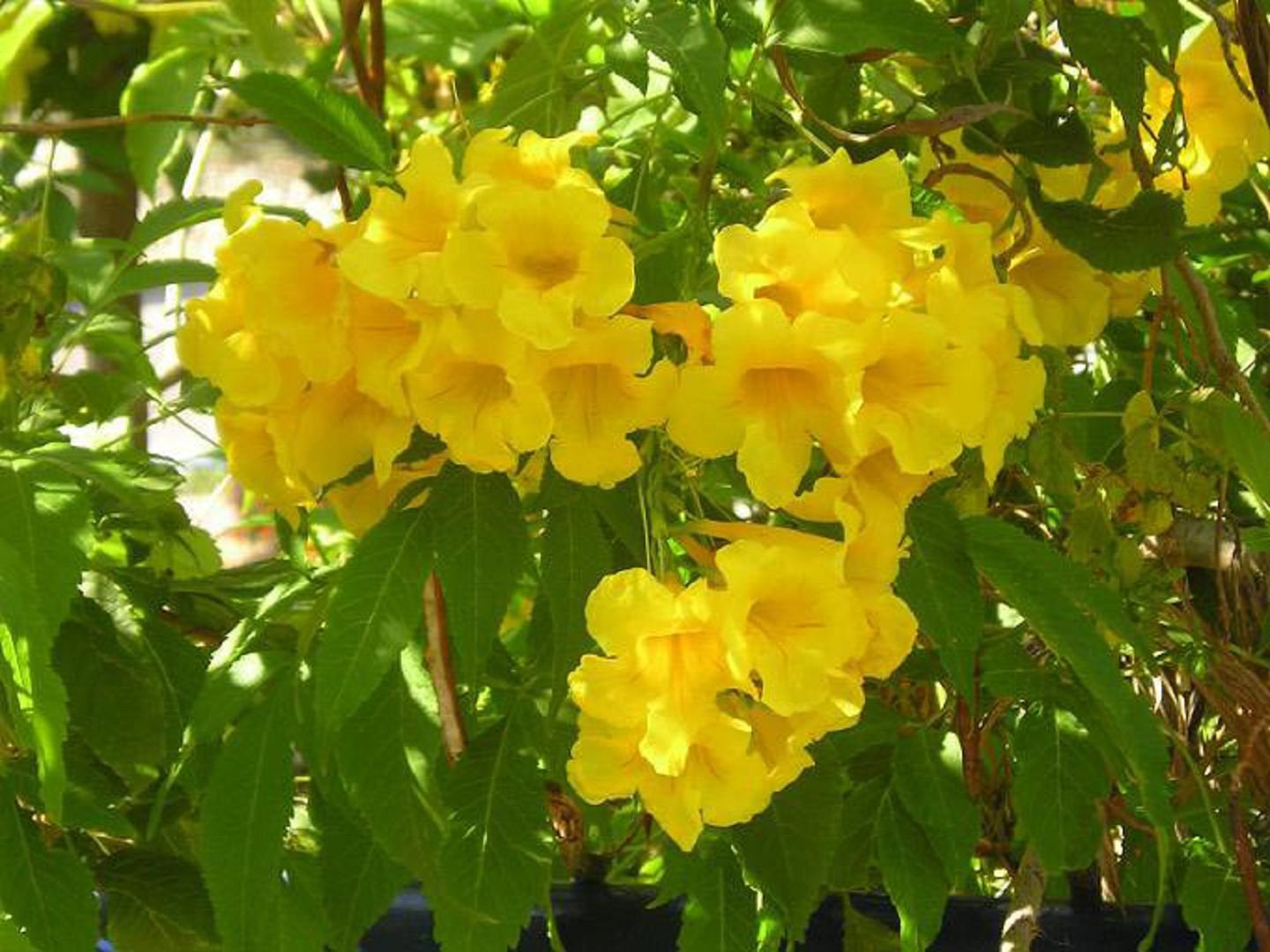

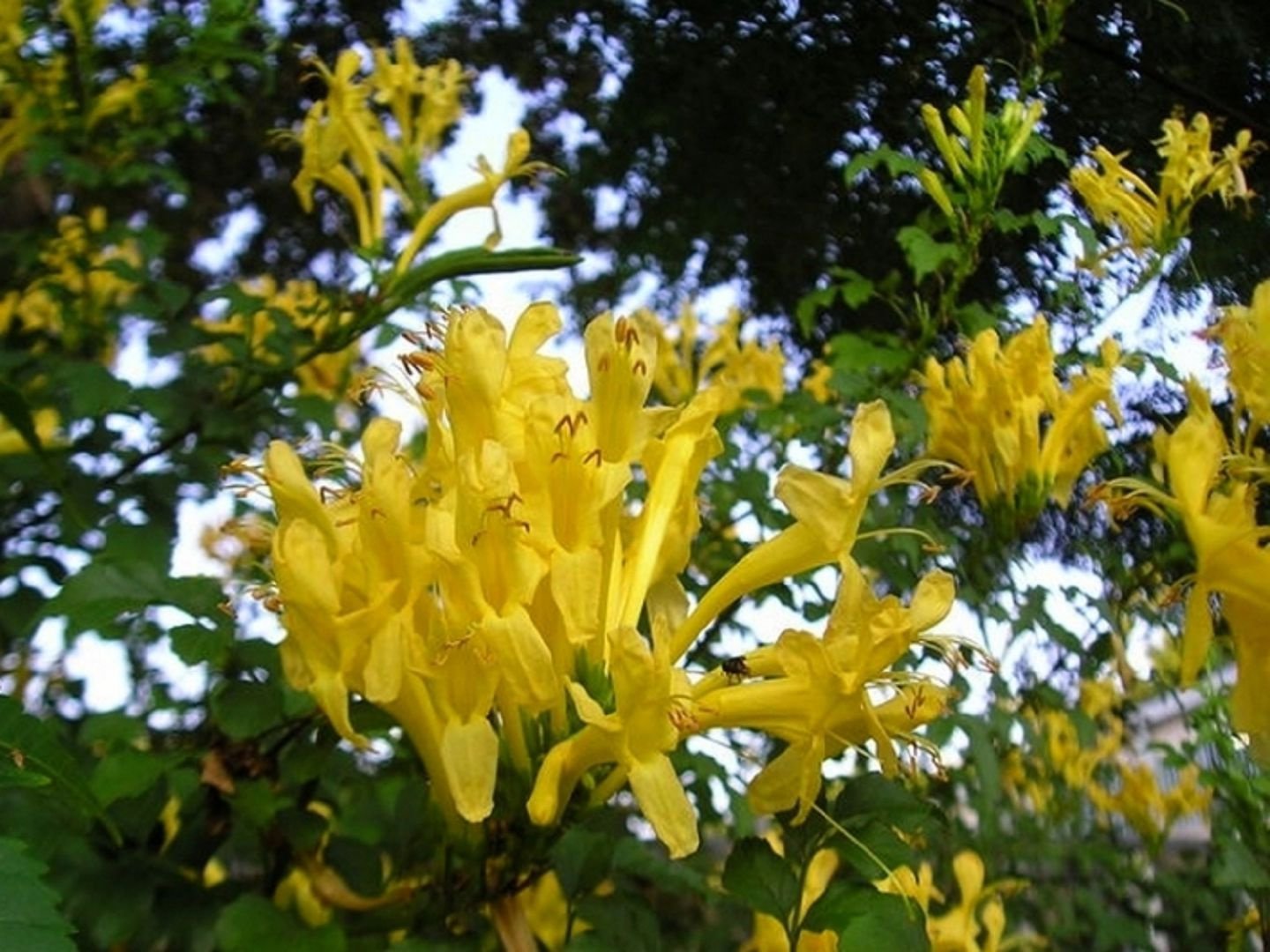
Numerous inflorescences bloom on the shoots throughout the summer. Each peduncle bears 2-8 tubular flowers with a diameter of up to 8 cm. The corolla consists of five petals fused at the base with curved edges. They are painted in pink, orange, crimson or golden color.
After pollination, hard pods of 8–10 cm long ripen on the vine. Small, hairy seeds of dark brown color are hidden in the bivalve pod. Fully ripened fruit opens independently and the wind easily carries the seeds over long distances.
Types and varieties of Kampsis
A small genus of Kampsis includes only 3 main types and several ornamental varieties.
The most common is. Liana with long (7-9 m) shoots can develop powerful roots in the internodes and cling to any surface. Each petiole contains 9-11 leaf plates with sparse pubescence on the reverse side. Tubular flowers reach a length of 6 cm. They are collected in wrist inflorescences at the tips of the shoots. Bright orange tube goes into the red limb at the ends of the petals. The plant prefers a warm climate, but is able to withstand short-term frosts of up to -20 ° C.
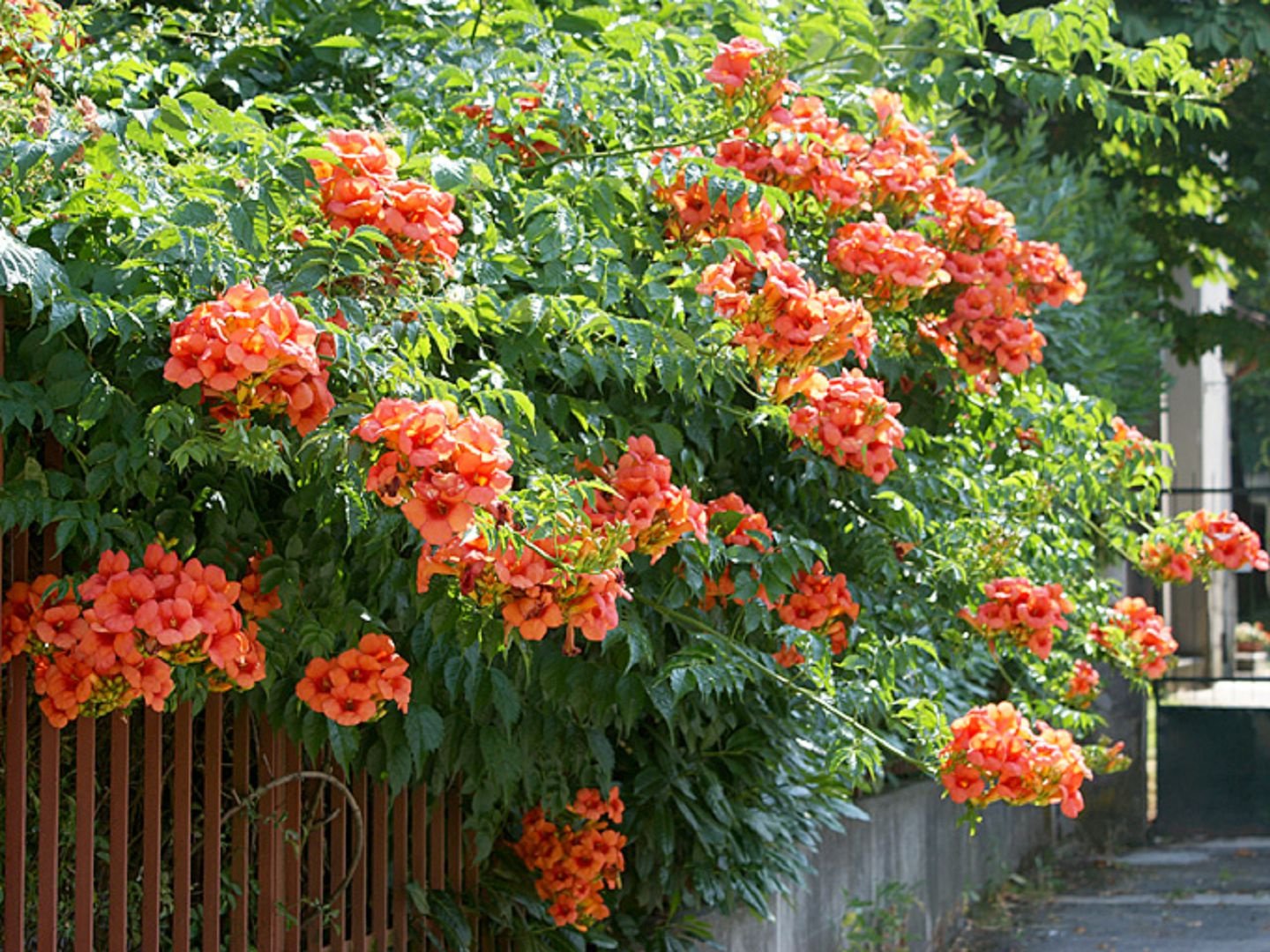
Popular varieties:
- Flamenco - vines up to 5 m long in July-October become covered with bright red buds;
- Flava - on the liana in July-September light yellow buds bloom;
- Early - blooms in early June with large flowers of rich red color.
Kampsis grandmother-flowered (Chinese). Flexible creeper without aerial roots braids support young shoots. On petioles there are 7–9 plumose leaves about 6 cm long. The pubescence on this species is completely absent. Flowers with a narrow tube in length are about 8 cm. They are painted in a fiery orange color. The shoots are more modest in size and often take the form of a sprawling bush. The plant prefers warm content, but can tolerate short-term frosts down to -18 ° C.
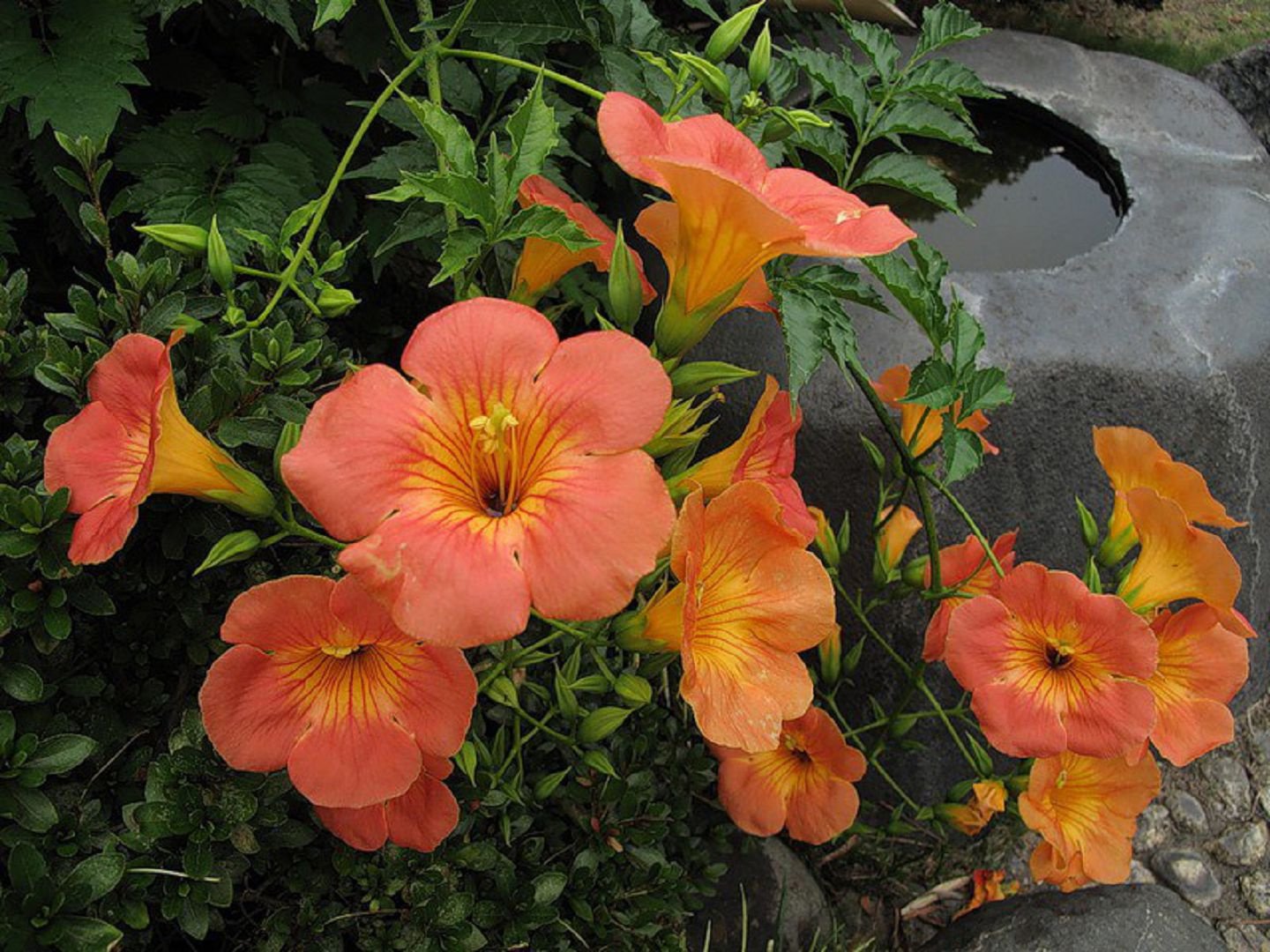
Relatively young variety with large flowers and flexible vines 4-6 m long. It has good frost resistance and high decorative effect. The popular Madame Galen variety is a spreading bush with red-orange large flowers.

Breeding methods
Reproduction of kampsis can be done by seed and vegetative methods. Seeds are pre-sown on seedlings. They do not need additional processing or stratification. It is enough in early March to distribute seed in boxes with loose, fertile soil at a depth of 5 mm. The pot is kept at a temperature of + 25 ° C and periodically moisten the ground. Shoots appear in 20-25 days. When a young vine grows 5-6 true leaves, it can be transplanted to a permanent place. The disadvantage of this breeding method is that the seedlings bloom only 7-8 years after planting, and the varietal qualities are poorly inherited.
Vegetative reproduction allows you to quickly get a lush flowering creeper with signs of the mother plant. For it uses such parts of vines:
- Cuttings In the first half of summer, the middle shoots are cut without buds. It is necessary to take a segment with 2-3 leaves, the leaf plate is cut to 2/3. Roots seedlings in sandy-peaty soil at an angle of 45 °. The soil near the plant is mulched and periodically watered. Viable roots appear within a month in 90% of the cuttings.
- Root growth. Root processes often appear around the bush. Even faster, they form when the rhizome is damaged, so after digging up the land near the kampsis, a lot of shoots are formed. They already have independent roots. It is enough to carefully dig up the plant in early spring or late autumn and transplant to a new place.
- Layering. In April-May, it is necessary to press down the half-woody escape of the Kampsis. All season, the soil near it is loosened and watered. By next spring, layering will have an independent rhizome. It is separated, the cut is treated with crushed charcoal and transplanted to a permanent place.
Growing from cuttings
Care rules
Campsis is characterized by high survivability and unpretentiousness. He, like a weed, is very actively growing and gives birth to offspring. However, in order to achieve abundant flowering, you need to follow a number of rules of care.
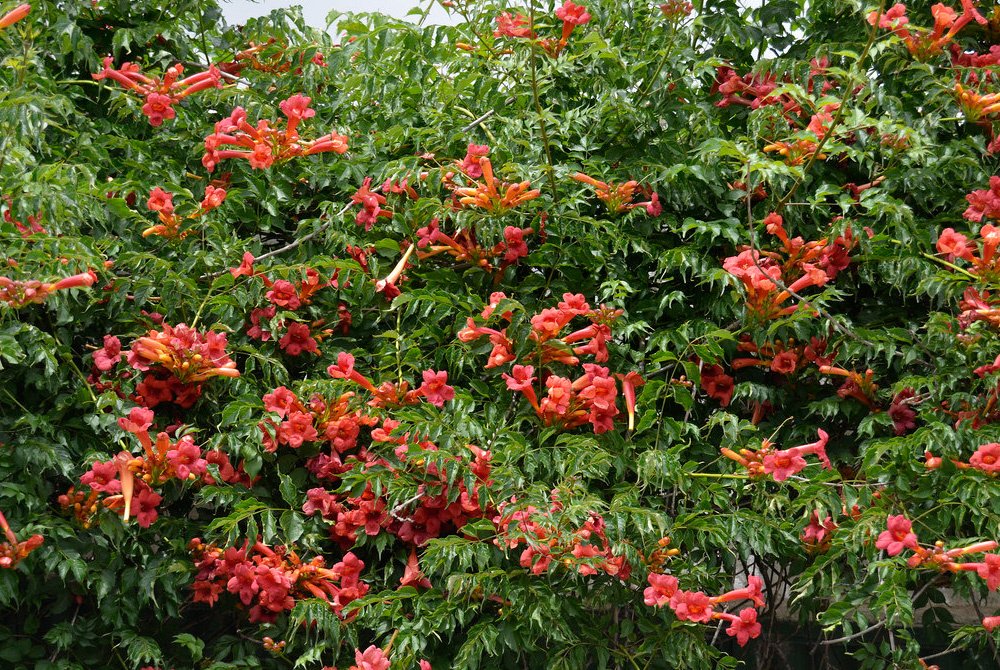
Lighting. For active growth and budding Kampsis needs a lot of light. It is better to choose open areas for it. Even in intense heat, direct sunlight will not cause burns.
Temperature. Best Liana feels in the warm southern regions. In the middle lane, shoots do not grow so actively, and for the winter they will require shelter. It is advisable to choose for planting a place protected from drafts.
Wintering. The roots of Kampsis are covered with lapnik branches, fallen leaves and sawdust. If the vines can be removed from the support and pressed to the ground, they are covered with the same material as the roots. Liana on the supports wrapped lutrasilom and polyethylene.
Watering. On hot days and during the flowering period, the campsis requires abundant watering, but can withstand a slight drought. It is important to prevent regular stagnation of water in the soil.
Top dressing. On fertile soil, the vine can grow at all without fertilizer. With a lack of nutrients, it is recommended to use nitrogen-phosphorus complexes. They will make flowering more abundant and long.
Crop. Regular pruning is necessary for Kampsis throughout the year. In early spring, some old or frozen shoots should be trimmed to stimulate the growth of young branches. It is on them bloom thick buds. As the buds wither, you can remove them and the pods. In the fall, a radical pruning should be carried out so that the vine does not extend beyond the designated area.
how to prune spring
Possible difficulties
Campsis is virtually free from disease. Only with frequent flooding of the soil can it be affected by root rot. Since the rhizome quickly gives rise to shoots, it is enough to change the conditions of watering and remove the affected areas.
Use of Kampsis
This beautiful, fast-growing liana will fill the garden with bright colors and wonderful aromas. It is perfect for decorating fences, arches or arbors. It should be planted near the outbuildings to hide the ugly walls under the green vines.
You can use flowers of kampsis for making bouquet compositions. They will stay in the vase for 1-2 weeks and will be pleased with bright colors.
It is important to remember that aerial roots of rooting kampsis are very strong. Rising along the wall of the house, they are able to grow into the thickness of the basement and bricks. Also fragrant flowers attract a lot of insects that can fly through the open windows into the room. For this reason, it is better to plant Kampsis at some distance from the house.
Let's get acquainted with the falling liana of the family Bignonievyh, the stem of which becomes woody in the process of growth. A garden plant Kampsis is often referred to by gardeners as an orange gramophone. Campsis or Texco is an extraordinarily decorative plant that is growing rapidly. The stalk of the kampsis is covered with roots, which cling to the support. Plant height can reach 15 meters, it perfectly closes unsightly walls and fences. Though the climate of a tekome is needed is mild, it grows beautifully in our gardens. Neither smoke nor gas pollution in the city conditions interfere with the plant.
Kampsis or Tacoma bloom
Kampsis plant - description
Campsis is a perennial, deciduous plant that tolerates frost well, although in harsh climates it is better to shelter in winter. The stems of the plant hover spirally over the support, when interlaced, form fancy shapes. The stems form a cap feathery dark green leaves up to 40 cm long and bright orange tubular flowers collected in drooping brushes.
Kampsis bloom
The bloom of Kampsis is long, so this plant will delight you all summer. After the flowers appear long boxes, which will also make the vine elegant, it happens that all winter.
How to care for Kampsis
The flower kampsis has a root that penetrates deep into the soil, after planting the plant needs to be watered, and then it does not require irrigation or fertilizer. After planting the Kampsis, you need to remove the weeds and loosen the soil, and if you want a more lush flowering, you can feed the vines with plants or ashes.

Campsis rooting
In flower beds and ornamental gardens, Kampsis is most often rooted, with brown shoots 5 cm thick. Creepers plants can reach three meters, and it happens that 10-15 m, climb the trellis on the roof of the house, and if the house is not high, you can cover it with a hat.
Soil for Kampsis
Planting and caring for Kampsis are fairly simple. Takoma to the soil is not demanding, but in order to achieve greater decorative effect, you need to plant it on fertile soils, or prepare a well for planting. Campsis likes sunny places, where it grows and blooms better.
Landing kampsis
In the fall, pits are prepared for planting the Kampsis, and plants are planted in the spring. The best time for planting the kampsis in the middle lane is the period before the blooming of the plant's buds, then it will be easier for it to settle down.
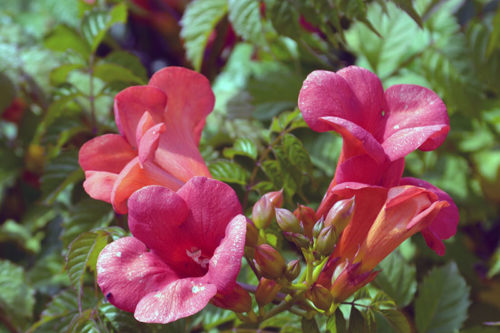
Campsis on the plot
Campsis can even be called an aggressive plant, as its ability to take root allows the roots to penetrate wooden window constructions, laying walls. Therefore, to grow Kampsis better away from buildings, on special supports.
Kampsis in the garden
Reproduction of the kampsis is best done by vegetative methods - green and root cuttings, layering, root suckers. Although liana Kampsis is grown from seeds that need stratification. Seeds should not dry out, otherwise they will lose germination.
Campsis (Tech) or Bignonia - one of the most popular plants used by gardeners and landscape designers in vertical gardening due to its high decoration. Its pinnate leaves consist of 7-11 small leaves. At the ends of the shoots form panicles of large tubular, gramophone-like flowers, the color of which, depending on the variety, varies from orange-red to pink.
Flowering teskoma from June to September. This deciduous vine has received its name for the ability of its shoots to bend and twist in the most bizarre way.
Kampsis grow under the force of even a novice gardener. However, despite its unpretentiousness, it is still worth first knowing the characteristics of planting and caring for Kampsis in order to admire its abundant blooms every year.
Types of Kampsis
The genus Kampsis includes 2 species that are cultivated in gardening:
Campsis rooting - liana, capable of using the air roots "rise" to a height of 15 m. Complex leaves reach a length of 20 cm and consist of 9-11 leaflets. Voronkovidnye flowers are collected at the ends of the shoots in panicle-shaped brushes of 10-15 pieces. They are disclosed sequentially, due to which the flowering is long;
Campsis rooting
Kampsis grandiflora - a feature of this species is the absence of aerial roots of the shoots (the plant clings to the support with the ends of the shoots). For this reason, it is characterized by a lower height than the Kampsis rooting. Most often forms a low bush.
![]()
Campsis big-flowered
Landing kampsis
Campsis is a heat-loving culture, therefore, in regions with a temperate climate, it is planted in open ground after the second decade of May. For planting a place on the site is chosen well lit and protected from the prevailing winds. It is not recommended to plant Bignonia near the windows of houses, as this plant attracts insects to itself.
Soil for kampsis will suit any, but the plant will have plenty of flowering only on fertile soil with a slightly acidic or neutral pH. Therefore, if the land on your site is scarce in nutrition, you should prepare a place for planting in the fall.
The landing pit is dug 0.6 m deep and 0.5 m wide. At the bottom, drainage is made of gravel or expanded clay. The excavated soil is mixed with humus or compost (5 kg per well) and complex mineral fertilizer (500 g per shrub), poured it back into the hole and left in this form until spring. Plants are planted in prepared pits in April (for the southern regions) or May (for the average climatic zone). After planting, the seedlings are watered, the ground in the near-hole hole is mulched with peat. Be sure to install a support for this vine (pergolas, arches, etc.) or plant it along the fences.
Reproduction of kampsis
Bignonia is propagated both by seeds and vegetatively (cuttings, layering, root shoots).
Seed method
This method has two drawbacks - seedlings do not retain the varietal characteristics of the parent plants and bloom later. Seeds do not require stratification, they have good keeping quality and germination. In the spring they are sown in boxes with loose fertile soil to a depth of 0.5 cm and germinated at room temperature. Approximately in 3-4 weeks shoots begin to appear. Seedlings are transplanted into the open ground after they grow 3 pairs of true leaves.
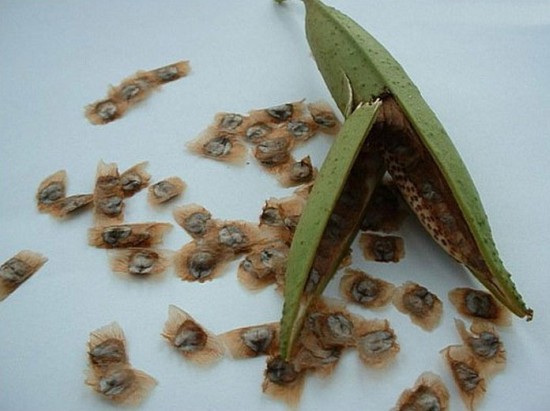
Kampsis seeds
Cuttings
Propagate Kampsis cuttings easier than ever because of their high survival rate.
The green cuttings of Bignonia are harvested in June-July from the middle parts of the shoots, on each of which only a couple of leaves are left. The lower ends of the cuttings are dipped in a rooting stimulator powder and planted at a 45 ° angle on the prepared site. After planting, the bed is watered and mulched.
Lignified cuttings are cut to a length of about 25-30 cm at the end of March, when the vine is still “sleeping”. To do this, use the shoots of the past year. The cuttings are planted immediately after cutting (if it is still cold outside, they are rooted at home).
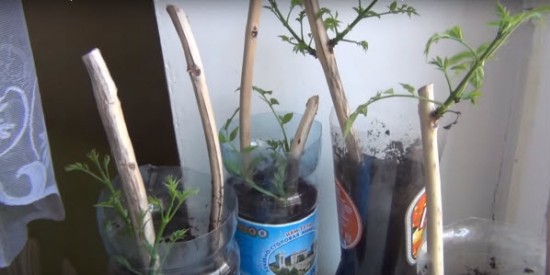
Successful rooting of lignified cuttings of the Kampsis: side shoots began to grow
Reproduction by layering
For reproduction, tacos by layering the lower shoot on the plant are bent to the ground and pinned. The place of contact of the stem with the soil is periodically watered. The next spring, the layers are separated from the “parent” and put on the chosen place.
Breeding shoots
Campsis gives abundant growth, which can be used for breeding. The procedure is carried out in early spring or autumn, when the vine is at rest. Leafy shoots are dug along with part of the root and planted in the selected area.
Care Kampsis: watering, feeding, pruning, shelter for the winter
Bignonia is not demanding in the care, which is watering, weeding, fertilizing, pest control and diseases.
Watering
This southern creeper is drought-resistant, however, in order to preserve its presentable appearance and abundant flowering, the irrigation regime must be adjusted so that the plant does not experience both a lack of moisture and its overabundance. To facilitate their work, tree trunks mulch.
Feeding
If the land on your site is quite fertile, then you can do without supplements. On poor soils, plants cannot do without additional nourishment. The introduction of nitrogen-phosphorus fertilizers will provide abundant and prolonged flowering of Campsis.
Cropping and crown formation
Tekome requires regular pruning, as this vine grows rapidly. To form a plant start after planting. Shoots shorten at a height of 15-20 cm from ground level. As they grow, the weak ones are removed, and the strong ones (4-5 pieces) are directed along the support in the right direction. The final kampsis will be formed in 3-4 years. Thanks to pruning Kampsis can be given a different shape.
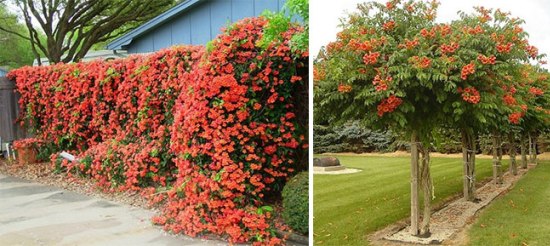
With the help of trimming Kampsis can be given any shape
Side shoots on skeletal branches are cut annually, leaving 2-3 buds on them. If the skeletal branch is frozen out in winter, then it is completely cut out “on the ring”, and in its place a replacement shoot is sent. Older plants are subjected to anti-aging pruning, in which all branches of the plant are shortened to 0.3 m. This procedure is carried out in early spring, before the buds are dissolved. During the growing season, in order to preserve the neat appearance of the vines, all faded shoots are cut, leaving 3-4 buds on them.
Wintering
In regions with prolonged frosts below -20 ° C, Campsis will need shelter for the winter. The branches are removed from the supports, placed on a cushion of spruce branches, covered with dry leaves or sawdust, covered with foil over it.
If the liana is already quite adult and it is not possible to remove it from the supports, then it is warmed as follows: the trunk circle is covered with lapnik, branches are wrapped with lutrasil and film.
Pests and diseases
Of the pest kampsis is affected aphid, which feeds on the juicy juice of young shoots and leaves. To combat it, spray plants with insecticides.
With excessive watering of this vine is likely to develop root decay. Therefore, you should adjust the irrigation regime, especially for young plants.
Why Kampsis does not bloom?
Bignonia may not bloom for the following reasons:
Insufficient age - this happens with those plants that were grown from seeds. They bloom only for 6-7 year of vegetation;
Spring frosts;
Root rot infestation;
Cold climate (in regions with cool summers, Kampsis refuses to bloom).

